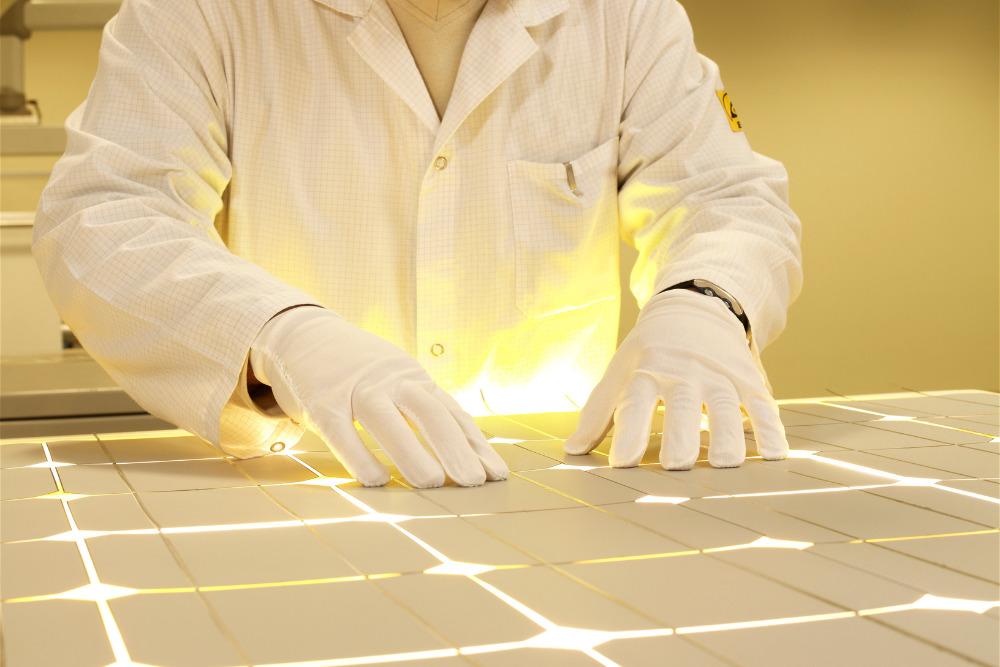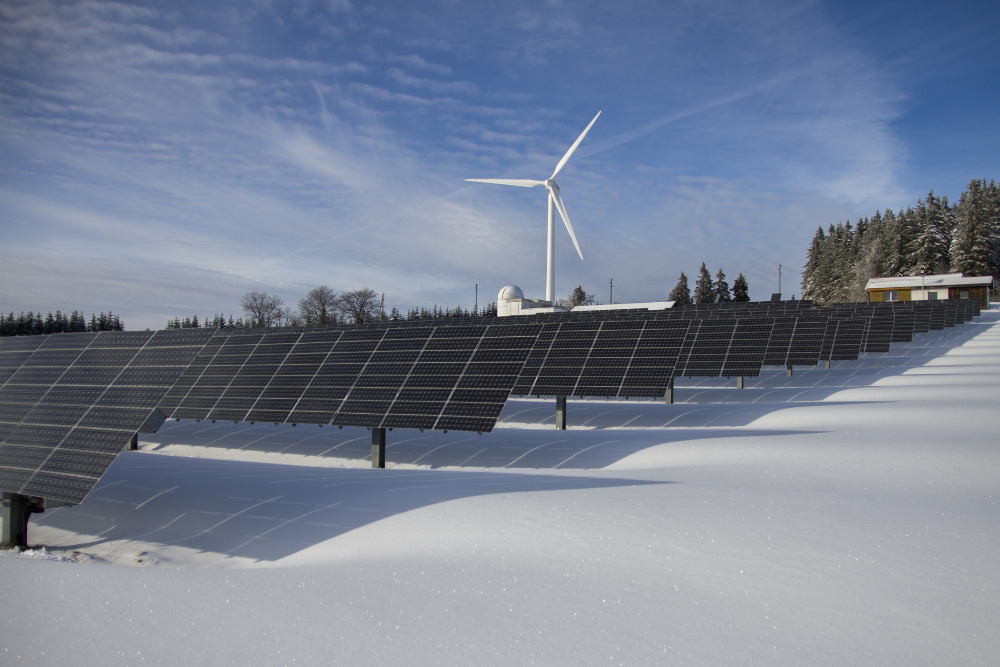
Today there are a variety of uses for solar panel technology, and those uses continue to evolve with advancements in materials, manufacturing techniques, and efficiency.
Although it may seem like a relatively recent invention, the photovoltaic effect was discovered in 1839 by French physicist Alexandre Edmond Becquerel. A short time later, Willoughby Smith uncovered the photoconductivity of selenium. Close to 200 years ago, these two discoveries laid the foundation for modern-day solar photovoltaic modules (PV modules).
Fast-forward to the 1990s, when solar panels became widely used for residential and commercial purposes.
Now, we're seeing innovations in solar manufacturing growing by leaps and bounds.
Today’s Solar Panels
Today’s solar technology has led to using three primary types of solar panels. These are:
- Monocrystalline solar panels. Made from a single silicon crystal structure, these panels have a uniform black appearance and high efficiency, typically ranging from 15% to 20%. Monocrystalline panels are space-efficient but are more expensive than other types.
- Polycrystalline solar panels. These panels are made from multiple fragmented silicon crystals. They have a speckled blue appearance and slightly lower efficiency than monocrystalline panels, usually ranging from 13% to 16%. Polycrystalline panels are more cost-effective and easier to manufacture, making them a popular choice.
- Thin-film solar panels. These panels are created by depositing a thin layer of semiconductor material, such as amorphous silicon, cadmium telluride, or copper indium gallium selenide, onto a substrate. They have a uniform or mottled appearance, depending on the material used, and their efficiency typically ranges from 7% to 12%. Thin-film panels are flexible, lightweight, and cost-effective, but they are better for low-energy applications and generally require more space for installation.
Emerging Technologies Increase Efficiency
Recent research and technological advancements in the solar industry have led to significant progress in the affordability and efficiency of solar energy. These improvements and solar energy’s sustainability continue to make solar energy systems a viable and competitive option as a low-cost energy source.
Some of the most notable advancements over the years include:
- Material Innovations. Researchers have been exploring new materials that can enhance the efficiency of solar panels while reducing manufacturing costs.
- Increased Efficiency. Improving the efficiency of solar panels directly impacts their cost-effectiveness. Over the years, researchers have made significant progress in increasing conversion efficiencies. Scientists have developed panels with higher efficiency ratings by optimizing the design of solar cells, reducing energy losses, and enhancing light absorption capabilities. This means more energy can be generated from the same surface area, reducing the number of panels required for a given installation.
- Manufacturing Techniques. Manufacturing advancements have contributed to cost reductions in solar panel production. Techniques like screen printing, laser processing, and thin-film technology have made solar power more efficient and cost-effective, allowing for greater energy production and improved panel quality. Automation improvements have also played a role in reducing manufacturing costs.
- Improved Energy Storage. Energy storage technologies, such as batteries, aid solar panels by storing excess energy generated during daylight hours for use during periods of low or no sunlight. Research and development efforts have focused on improving energy storage systems' efficiency, durability, and affordability.
- System Integration and Smart Grids. Integrating solar energy systems with smart grid technology enables better management and optimization of power generation and consumption. Research in grid management, power electronics, and intelligent control systems has facilitated the seamless integration of solar panels into existing electricity networks. This integration maximizes solar energy utilization, reduces costs associated with grid infrastructure upgrades, and enhances overall system efficiency.
- Economies of Scale. As the solar industry has grown, economies of scale have come into play, driving down the costs of solar manufacturing, solar installation, and system maintenance. Increased demand for solar panels and establishing of large-scale manufacturing facilities have led to greater production capacity and improved supply chains, resulting in lower costs per watt.

With the many breakthroughs in solar technology in recent years use of solar power has grown exponentially.
According to the International Energy Agency, as of 2021 generation of solar PV had increased by 22%, which was 3.6% of worldwide energy production. And with current initiatives aiming for net zero emissions by 2050, that trend needs to continue and increase to an annual energy generation growth rate of 25%.
Latest Innovations In Solar Panel Manufacturing
With the aggressive objectives regarding renewable energy in the coming years, several innovations and next-generation technologies will begin becoming more widely used for harnessing solar energy.
Some of the most promising are listed below.
PERC (Passivated Emitter Rear Cell)
Passivated Emitter Rear Cell (PERC) is a solar photovoltaic (PV cell) technology to improve efficiency and performance. PERC technology has gained significant attention in recent years due to its ability to enhance the power output of solar panels.
Traditional solar cells have a front-side emitter, where the incoming sunlight is absorbed and converted into electrical energy. In PERC cells, the rear side of the cell is also passivated and acts as an additional emitter. This allows for improved absorption of sunlight and better conversion efficiency.
PERC cells typically achieve efficiencies of 20% to 23%,
Heterojunction Technology
Heterojunction Technology (HJT) is a newer solar cell technology combining multiple layers of semiconductor materials to create highly efficient photovoltaic cells. HJT cells are known for their exceptional efficiency, low-temperature coefficient, and improved performance in real-world conditions.
Bifacial Solar Panels
Bifacial solar panels are photovoltaic modules that can generate electricity from both sides of the panel, capturing sunlight from both the front and rear surfaces. Unlike traditional solar panels that only utilize the front side, bifacial panels have transparent back sheets or glass that allow light to pass through and reach the rear side of the cells.

Half-Cut Solar Cells
Half-cut solar cells are a type of photovoltaic cell that is physically divided into two halves, usually along the busbar in the middle.
Half-cut solar cells are manufactured by dividing a standard-sized solar cell into two equal halves, effectively creating two smaller cells. This division reduces the current flowing through each half, resulting in lower resistive losses and improved performance.
Shingled Solar Panels
Shingled solar panels are photovoltaic modules with an interconnected cell design. In shingled panels, solar cells are overlapped and interconnected with conductive adhesives or ribbons, creating a “shingle” effect. This design eliminates the traditional use of busbars. It allows for a larger active cell area, increasing the module’s power output.
The shingled interconnection also reduces the shading on the cell surface, enhancing the panel’s performance in low-light and partially shaded conditions. With their improved efficiency and enhanced aesthetics due to the absence of visible busbars, shingled solar panels are becoming increasingly popular in residential and commercial installations, driving the advancement of solar energy technology.
Multi-Busbar (MBB) Technology
Multi-Busbar (MBB) technology is a solar cell design that improves the performance and efficiency of photovoltaic modules. MBB cells feature multiple, narrower busbars instead of the traditional single thick busbar used for electrical interconnection.
By distributing the current across multiple busbars, MBB technology reduces the losses within the cell, enhancing electrical conductivity and efficiency. The narrower busbars also allow for a larger surface area of the cell to be exposed to sunlight, increasing light absorption and power generation.
MBB technology has gained traction in the solar industry due to its ability to deliver higher module efficiencies and improved temperature coefficients, resulting in enhanced energy output and greater system reliability.
Laser Scribing and Advanced Cell Cutting Techniques
Laser scribing and advanced cell-cutting techniques are cutting-edge methods to manufacture solar cells to increase their performance and efficiency.
Laser scribing involves high-precision lasers to create precise patterns or grooves on the surface of solar cells. These patterns help separate the cells into smaller sections, improving the current flow and reducing power losses caused by shading and resistance.
Additionally, advanced cell cutting techniques, such as diamond wire sawing or laser cutting, allow for precise and clean cutting of the solar cell wafers, minimizing waste and ensuring high-quality edges. These techniques enable the production of thinner wafers, reducing the amount of crystalline silicon used.
Perovskite Solar Cells
Perovskite solar cells are an emerging technology that creates highly efficient and low-cost solar energy conversion.
Perovskite has a unique crystal structure similar to the mineral perovskite. Perovskite solar cells are typically composed of a thin layer of perovskite material sandwiched between two conductive layers. These cells have demonstrated rapid efficiency improvements, reaching levels comparable to traditional silicon-based solar cells.
Perovskite solar cells offer several advantages, including their ability to be manufactured using inexpensive and easily scalable processes such as solution processing and printing techniques. This makes them cost-effective for large-scale production.
However, there are still challenges to overcome, such as stability issues related to moisture and temperature sensitivity.
What Is The Most Efficient Type Of Solar Panel?
Currently, the most efficient type of solar panel for general consumer use is the Monocrystalline solar panel.
Although these tend to be more expensive, their compact size and long lifespan make them the best choice for the time being.

